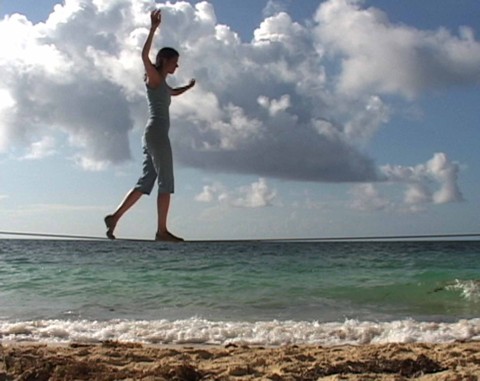The body—not only its form but also its processes and performance—has been the focus of Janine Antoni’s thirty-five-year career. Trained as a sculptor at Rhode Island School of Design, where she earned her MFA in 1989, Antoni creates legendary artworks using unconventional and seemingly mundane materials and substances that nonetheless express profound social and cultural meanings.
Gnaw (1992) consists of two six-hundred-pound blocks of lard and chocolate from which the artist chewed and repurposed the material removed. The chocolate became forty heart-shaped candy boxes, and the lard, combined with pigment and beeswax, was shaped into 150 tubes of lipstick. With Lick and Lather (1993), Antoni returned to chocolate, plus soap, to create fourteen busts of her own visage. Before mounting them on pedestals, she resculpted the seven chocolate busts by licking them, and she bathed with the seven soap busts. For both pieces, the intimate, everyday acts of eating and bathing were part of the artmaking process and literally and figuratively expressive of the artist’s being.
In 1992, Antoni also performed Loving Care (1992). Dressed in a black bodysuit, she dipped her long hair into a bucket of black dye and proceeded to mop the floor of the gallery with her soaked strands. In Butterfly Kisses (1992), the artist coated her eyelashes with Cover Girl Thick Lash mascara to leave the residue of 1,254 winks on each page with either eye. Apart from the unconventional production of Abstract Expressionist “paintings,” Antoni transformed gender-coded objects and actions into clever commentaries on histories of art and feminism.
In the early 2000s, Antoni would become skilled at new techniques to create art. She learned ropemaking for Moor (2001). Rather than jute, sisal, or coir, she created a rope from personal items gifted from friends and relatives. Antoni twisted and tied together flowers, string lights, rosary beads, electric cords, and other objects into a 256-foot-long rope. The experience of producing Moor inspired her 2002 video Touch, as the making of a rope led to a desire to walk on one.
Antoni practiced tightrope walking an hour a day for months. Continually facing the loss of her balance, she learned to be comfortable with being uncomfortable. Once proficient at her new skill, she returned to her childhood home in Freeport, Bahamas. There, within the view of the Atlantic Ocean that she often observed from her window, she mounted a tightrope directly above the horizon line and filmed herself walking back and forth across it.
For Antoni, the horizon is “about the future, about the imagination” and the world beyond her home that her mother encouraged her to experience. In the video, her footsteps cause the tightrope to dip and “touch” the horizon periodically. The artist said, “I want to walk in this impossible place, to walk on the line of my vision, or along the edge of my imagination.” As she walks across the rope, we witness the challenge of her endeavor. Her arms waver in her effort to stay balanced. Her legs and torso wobble as each foot cautiously slides across the rope.
The horizon nevertheless, is not a physical site, but a visual phenomenon which conjures one's dreams, desires, and possibilities. Antoni momentarily visualizes reaching that state by seeming to touch down onto it. As in earlier work, a habitual everyday action such as walking, like eating and bathing, becomes a wondrous transformative process of making art. It interpolates Antoni’s teetering figure in an idyllic setting of sea, sky, and sand, where she embodies the struggles as well as the strength in attempting to reach new horizons. — Kanitra Fletcher

